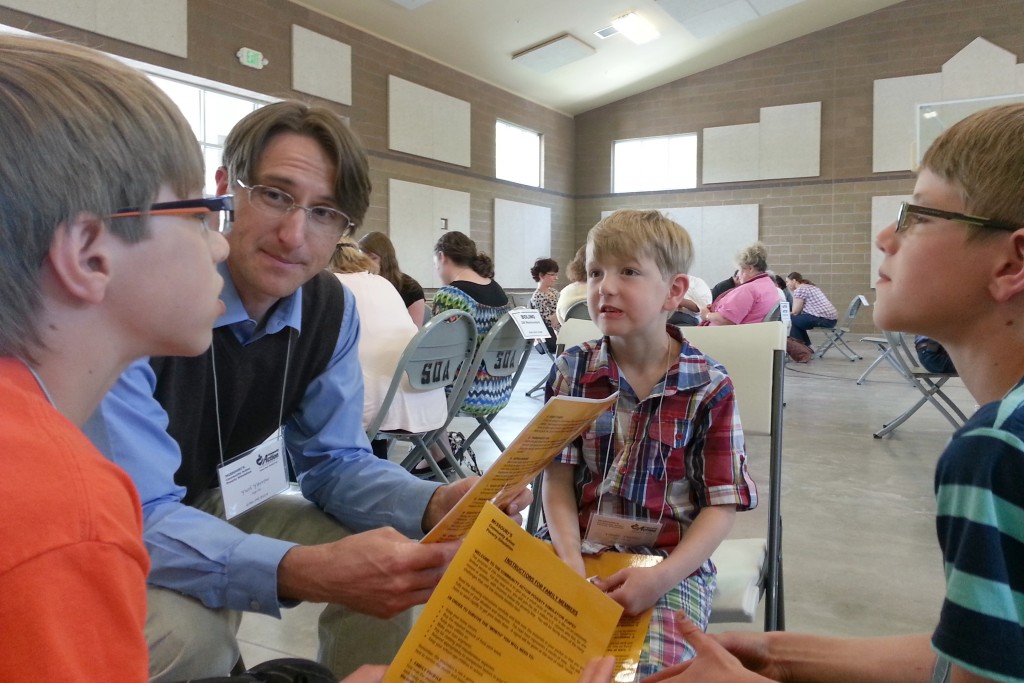Community Action Services and Food Bank (CASFB) held a poverty simulation Wednesday to better prepare employees and volunteers to understand the unique difficulties that confront low-income families in Utah Valley.
Using a simulation kit, participants role-played the experiences of individuals facing the challenges of suburban poverty.
Meeting at the Provo Seventh-day Adventist Church, faux family groups met for a few minutes to read over their individual roles and discover what their particular life circumstances were going to be for the next two hours. Some held jobs or were recipients of government programs while others found out that they would be disabled or senior citizens living on Social Security benefits.
Employees and volunteers were asked to work together during the simulation to understand the overall plight of those they help through their efforts at CASFB.
“The poverty simulations are conducted to give people an inkling of what it’s like to live in a household where there are not enough resources,” said Myla Dutton, CASFB’s executive director.
Each participant had tasks designed to approximate the stresses of providing basic necessities and shelter on a limited budget during the course of four 15-minute “weeks.” Participants interacted with human service agencies, grocers, pawnbrokers, bill collectors, job interviewers, police officers and others.

Serving as executive director for the organization for 34 years has given Dutton a great deal of perspective. She became visibly emotional while explaining that suburban poverty is growing rapidly in Utah County.
“These are our friends and neighbors,” Dutton said. “Times are changing. These numbers aren’t going down. The latest census records indicate that 73,000 people are living at or below the federal poverty line in this county. The poverty line is drawn at $22,000 per year for a family of four.”
She said those who suffer from poverty conditions typically try not to draw attention to themselves.
“It’s tough for families to ask for help,” Dutton said. “But, there is help and we want to make it easier for people to understand what their resources are . . . and our staff needs to understand a little of how it feels.”
The simulation was often lively. People could be heard negotiating for better circumstances, but frequently being disappointed with the limited value of their resource cards.
Craig Severinsen, simulation leader and communications director for CASFB, periodically wandered through the crowd handing out “luck of the draw” cards that could change the fate of an individual and their entire family. These cards could either improve or worsen the problems participants were facing.
Chris Quinlen, an employee with CASFB, brought his three young sons to the simulation to give them a taste of how important the issues facing impoverished families are. Michael, 12, Mathieu 10, and Marc 7, each took on a family role with their father. Michael even had to play the role of an overworked and underpaid mother.
“Since I was disabled in my role, he had to deal with some problems he wasn’t expecting,” Quinlen said. “It was very revealing for him to feel so much pressure as the only bread winner . . .getting himself to work and then to the grocery story and paying all the bills.”
At one point, Michael said he couldn’t do it all by himself anymore and during a family meeting told everyone he needed help.
“That’s when we revised our plan,” said Quinlen. “He had experienced the domino effect of having his cash stolen, then losing transportation and then being fired at work. Unable to pay rent, we were evicted from our apartment. He was able to see how a chain reaction gets started.”
At one point, Michael, in the role as the family’s mother, went to the pawn shop with resource cards that represented items like a TV and furniture. When he wasn’t given the value labeled on the card, he was completely surprised.
“It was a good exercise for all three of the boys to see how conditions would drive you to do certain things,” Quinlen said. “We talked about the experience over dinner and they all three expressed appreciation for the fact that you don’t know who might be in those types of situations and you want to be ready to help whenever you can. Volunteering is important. Even a little bit can help.”
Dutton explained that a CASFB poverty simulations are held at different times for different groups. One was held for community leaders and policy makers in 2012 to assist with a broader awareness of poverty.




